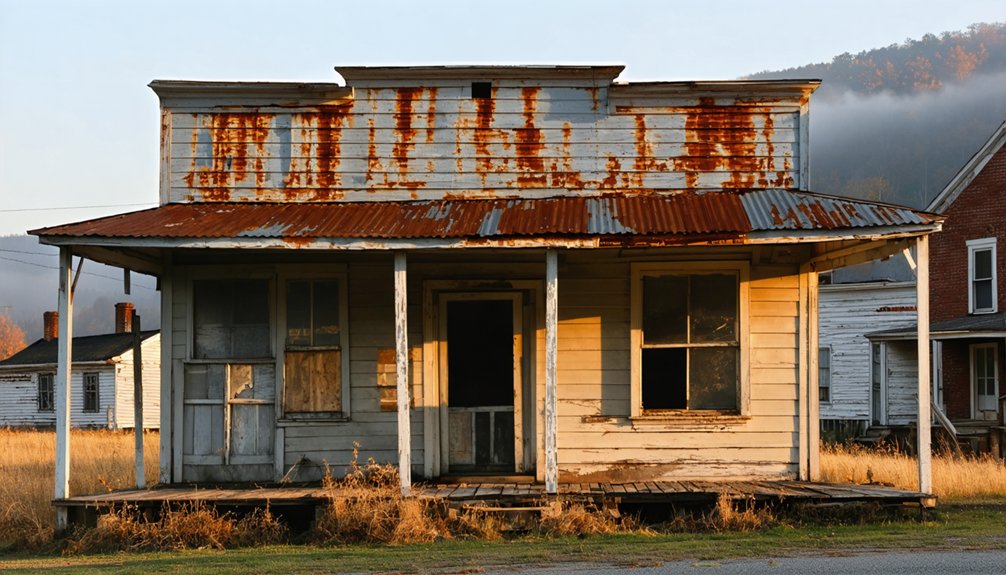You’ll find Paradise, Kentucky‘s haunting remains along the Green River, where this once-vibrant settlement began as Stom’s Landing in the early 1800s. The town flourished as a trading post before coal mining transformed it into an industrial hub. In 1967, the Tennessee Valley Authority’s Paradise Fossil Plant forced residents to abandon their homes due to severe environmental hazards. Today, only the hilltop Smith Family Cemetery and John Prine Memorial Park preserve this community’s remarkable story.
Key Takeaways
- Paradise began as Stom’s Landing in the early 1800s before becoming a thriving river trading post along Kentucky’s Green River.
- The town transformed from a commercial hub into a coal mining community after rich coal deposits were discovered in the area.
- Environmental destruction and health hazards from coal operations forced the Tennessee Valley Authority to buy out residents in 1967.
- The Paradise Fossil Plant replaced the town, becoming Kentucky’s highest-output power facility with 2,632 megawatts of generation capacity.
- Only the Smith Family Cemetery remains from the original town, containing headstones dating to the 1750s overlooking the former settlement.
The Origins of Paradise’s Name
While Paradise, Kentucky eventually became known as a ghost town, its origins trace back to a humble river settlement called Stom’s Landing in the early 19th century. Founded by Leonard Stom between 1800 and 1820, this essential trading post along the Green River served as a significant commercial hub for about 40 years. The name evokes the ancient concept of a walled enclosure, much like the original etymological meaning of paradise itself.
You’ll find several name theories surrounding Paradise’s historical significance. While some suggest the town was briefly called Monterey, the evidence doesn’t support this claim.
By 1852, the settlement officially became Paradise, though the exact reason remains unclear. Local legend tells of a traveling family who found the area so beautiful they dubbed it Paradise, while others believe settlers simply chose the name to describe the idyllic natural setting. A heartwarming story tells of a family whose sick child experienced a miraculous overnight recovery while camping near the settlement.
The Paradise post office’s establishment on March 1, 1852, marks the first official use of the name.
Life Along the Green River
After Kentucky’s initial settlement in 1775, pioneers quickly recognized the Green River valley’s potential, establishing a thriving network of farms and trading posts along its fertile banks.
You’d have found flatboats laden with crops and timber heading downriver to New Orleans, while steamboats like the McLean churned upriver to Bowling Green.
The river commerce transformed dramatically in the 1830s when locks and dams made year-round navigation possible, quadrupling trade volume. Local sawmills in Evansville processed the steady stream of timber flowing from the Green River Valley.
Infrastructure improvements in the 1830s revolutionized Green River trade, as new locks and dams enabled continuous navigation and massive growth.
You could’ve witnessed farmers and merchants prospering as transportation costs dropped below railroad rates.
The river’s significance extended far beyond commerce – archaeological evidence shows Native Americans thrived here thousands of years earlier, leaving behind shell middens that tell stories of communities who, like the later settlers, depended on the Green River’s bounty.
Following the American Revolution, land grant veterans established homesteads along the waterway, marking the beginning of permanent European settlement in the region.
From Ferry Landing to Mining Hub
Before becoming a booming coal town, Paradise started as Stom’s Landing – a bustling Green River trading post where steamboats and flatboats would dock to exchange goods.
You’d find the ferry history of this strategic settlement stretching back to the early 1800s, when river trade dominated local commerce along this crucial tributary of the Ohio River.
The picturesque setting earned its new name “Paradise” from awestruck settlers who recognized the area’s natural bounty.
By 1852, the establishment of a post office marked the community’s growing importance.
But you’ll find the most dramatic transformation came as coal companies discovered the region’s rich deposits.
The once-peaceful river landing evolved into an industrial hub as Peabody Coal and Pittsburgh & Midway moved in, forever changing the community’s destiny from river commerce to coal extraction.
The Tennessee Valley Authority’s Paradise Steam Plant transformed the landscape, making farming impossible in the surrounding area.
Sadly, the town was ultimately torn down in 1967 when the Tennessee Valley Authority deemed it uninhabitable due to health concerns.
The TVA Buyout and Town’s Final Days
Once the Tennessee Valley Authority started operating its massive Paradise Fossil Plant in the 1960s, the fate of Paradise’s remaining residents became sealed.
You’d have witnessed the town’s slow suffocation as coal ash from the plant rained down on homes and gardens, while strip mining operations ravaged the surrounding landscape.
By 1967, the environmental destruction and health hazards had become unbearable, forcing a decisive turning point. The TVA initiated a thorough buyout process, purchasing every property in Paradise to expand their operations.
Through this community relocation, you would’ve seen your neighbors pack up their lives and leave their homes behind. The town was then demolished, marking the end of Paradise as a living community – a sacrifice to industrial progress and power generation. The plant would go on to achieve 2,632 megawatts of power generation capacity, becoming Kentucky’s highest-output facility. After years of service, the facility’s final unit, Paradise Unit 3, closed in 2020 despite strong political opposition.
What Remains: The Hilltop Cemetery
Today, the Smith Family Cemetery stands as the sole witness to Paradise’s former existence, perched atop a hill overlooking what was once a bustling river town. Within this preserved grounds, you’ll find headstones dating back to the 1750s, marking the final resting places of the region’s earliest settlers who built their lives along the Green River.
The cemetery’s historical significance extends beyond mere preservation – it’s the last physical connection to Paradise’s community heritage. The TVA buyout in 1967 led to the cemetery becoming the only remaining original structure from the town.
While the Paradise Fossil Plant looms nearby, this hilltop sanctuary has remained intact through decades of environmental change and industrial development.
You can still visit this remarkable site, where the gravestones tell silent stories of Kentucky’s past, offering a tangible link to the pioneering families who first called this area home.
John Prine’s Musical Tribute
While Paradise, Kentucky faded into history, John Prine’s 1971 folk masterpiece “Paradise” guaranteed the town’s story would echo through generations.
Drawing from childhood memories of visiting his parents’ home region, Prine’s nostalgia intertwines with sharp cultural critique of Peabody Energy‘s devastating strip mining operations.
Through Prine’s childhood recollections, the raw scars of strip mining meet bittersweet memories of a vanishing Kentucky homeland.
You’ll hear the heartache in his lyrics about “Mister Peabody’s coal train” hauling away both the land and a way of life. The song brought national attention to environmental destruction in Kentucky’s coal country while cementing itself as an anthem of resistance against industrial excess.
In a poetic final chapter, Prine’s ashes were scattered on the Green River in 2020, fulfilling the song’s prophetic last verse and forever binding him to the landscape he immortalized. Today, visitors can pay their respects at the John Prine Memorial Park dedicated in 2022 near the Rochester Dam.
Environmental Legacy and Modern Impact

When you visit Paradise today, you’ll find a stark environmental legacy from decades of coal mining and power generation that transformed the once-thriving community into an industrial zone marked by persistent health hazards from airborne emissions.
The Paradise Fossil Plant’s conversion from coal to natural gas operations in 2017 signaled a shift in regional energy production, though decades of coal ash and mining waste continue to impact local soil and water quality.
The surrounding habitat bears little resemblance to its pre-industrial state, with strip-mined landscapes and industrial infrastructure replacing the original farmland and riverside settlement that characterized Paradise before 1959.
Emissions and Public Health
As the Paradise Fossil Plant dominated the landscape of the former town site, its coal-burning operations released toxic emissions that devastated public health and the environment for decades.
You’ll find that the plant’s legacy of coal ash and airborne debris settled like toxic snow across the region, leading to severe respiratory issues among residents. The persistent air quality degradation forced many to accept buyouts and abandon their homes by 1967.
- Coal combustion produced hazardous particulate matter and sulfur dioxide
- Residents developed asthma and chronic bronchitis from toxic exposure
- Environmental poisoning concerns sparked TVA relocation decisions
- Long-term exposure increased risks of cardiovascular disease and lung cancer
- The conversion to natural gas reduced emissions but couldn’t erase decades of damage
Habitat Transformation Over Time
Before Paradise became an industrial wasteland, you’d find a thriving ecosystem of rolling hills, limestone gorges, and mixed hardwood forests teeming with biodiversity.
You’d witness cypress swamps along the Green River’s banks, where diverse aquatic life flourished and local farmers cultivated fertile soil.
But as strip mining intensified in the early 20th century, you’d see dramatic habitat loss transform the landscape.
Mining operations tore away entire hillsides, leaving barren craters where forests once stood.
The Green River, once a crucial ecological corridor, suffered from sedimentation and acid mine drainage.
While some invasive species have colonized the disturbed areas, meaningful ecological restoration remains challenging.
Heavy metal contamination and altered hydrology continue to suppress natural regeneration, leaving Paradise’s environment a shadow of its former richness.
Coal to Natural Gas
- Natural gas generates cleaner electricity with reduced emissions.
- Former coal miners face displacement as jobs shift to new energy sectors.
- Environmental recovery efforts focus on healing strip-mined landscapes.
- Coal’s decline prompted widespread community migration to urban areas.
- Local economic revitalization now centers on sustainable energy development.
- https://dablogfodder.blogspot.com/2017/01/paradise-kentucky.html
- https://en.wikipedia.org/wiki/Paradise
- https://thestoms.com/StomTree/Paradise.html
- https://www.onlyinyourstate.com/experiences/kentucky/ghost-town-ky
- https://kids.kiddle.co/Paradise
- https://www.youtube.com/watch?v=AyHrapNoTG4
- https://rockportky.com/Paradise/ParadiseTown/ParadiseTown.html
- https://www.loe.org/shows/segments.html?programID=19-P13-00008&segmentID=2
- https://paradisekentucky.wordpress.com/history/
- https://www.courier-journal.com/story/life/2023/09/07/robert-m-rennick-researched-history-of-odd-kentucky-town-names/70508888007/
Frequently Asked Questions
What Was the Average Home Price in Paradise Before the Buyout?
You’ll find exact Paradise home prices aren’t documented in real estate trends, but given the town’s historical significance and rural Kentucky location, modest working-class homes likely averaged $5,000-$15,000 during the 1960s buyout.
Did Any Residents Successfully Resist or Refuse the TVA Relocation?
Based on available records, you won’t find evidence of successful resistance strategies or community solidarity against TVA’s relocation. All residents ultimately accepted the buyout, leaving only the cemetery behind.
Were There Any Schools or Churches in Paradise?
Just like texting back then, you’d find both schools and churches in Paradise. The Paradise School served local kids, while churches formed the spiritual backbone of your close-knit Kentucky community.
What Native American Tribes Originally Inhabited the Paradise Area?
You’ll find that Shawnee and Cherokee native tribes were the primary inhabitants of this area, with evidence showing their cultural heritage through archaeological sites along the Green River region.
How Many Businesses Operated in Paradise During Its Peak Years?
Imagine a bustling river town that’s now just dust in the wind. You’d have found roughly 12-15 businesses during Paradise’s peak, including general stores and river trading posts, before economic decline swept through.



